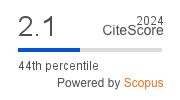Avoiding Congestion for Coap Burst Traffic
DOI:
https://doi.org/10.4108/eetiot.v9i1.2655Keywords:
Congestion control, Internet of Things, Rate controlAbstract
Congestion is an important issue in Internet of Things (IoT) networks with constrained devices and a growing number of applications. This paper investigated the problem of congestion control for burst traffic in such networks. We highlight the shortcomings of the current constrained application protocol (CoAP) in its inability to support burst traffic and rate control. Subsequently, we propose an analytical model for CoAP burst traffic and a new rate-control algorithm for CoAP to avoid congestion. A CoAP sender increases or decreases the transmission rate depending on the congestion detection. Using simulations, we compared the performance of the proposed algorithm with the current CoAP in various traffic scenarios. Experimental results show that the proposed algorithm is efficient for burst traffic and provides better performance in terms of delay, throughput, retransmission, packet duplication, and packet loss compared to CoAP.
Downloads
References
Gomez C., Archia-Moret A., Crowcroft J., et.al., TCP in the Internet of Things: from ostracism to prominence, IEEE Internet Computing, 2018, vol. 22, Issue 1, pp. 29-41.
Tariq M.A., Khan M., Khan M.T.R., Kim D., Enhancements and Challenges in CoAP–A Survey, Sensors, 2020, DOI: 10.3390/s20216391, vol. 20, 2020 (6391), pp. 1-29.
RFC 7252, The Constrained Application Protocol (CoAP), available: https://rfc-editor.org/info/rfc7252.
Haile H., Grinnemo K., Ferlin S., et.al., End-to-end congestion control approaches for high throughput and low delay in 4G/5G cellular networks, Computer Networks, 2021, vol. 186.
Bormann C., Shelby Z., Block–Wise Transfers in the Constrained Application Protocol (CoAP), [Online]. Available: https://rfc-editor.org/info/rfc7959.
Betzler A., Gomez C., Demirkol I., Paradells J., CoAP congestion control for the internet of things, IEEE Commun. Mag., 2016, vol. 54, no. 7, pp. 154–160.
Bormann C., Betzler A., Gomez C., Demirkol I., CoAP Simple Congestion Control/Advanced, Internet-Draft, Feb. 2018. [Online]. Available: https://tools.ietf.org/id/draft-bormann-core-cocoa-03.txt.
Betzler A., Gomez C., Demirkol I., Paradells J., CoCoA+: An advanced congestion control mechanism for CoAP, Ad Hoc Netw., Oct 2015, vol. 33, pp. 126–139.
Deshmukh S., Raisinghani V.T., AdCoCoA–Adaptive Congestion Control Algorithm for CoAP, in Proc. of 11th IEEE Int. Conf. on Computing, Communication and Networking Technologies (ICCCNT), Kharagpur, India, Jul. 2020, pp. 1-7.
Aimtongkham P., Horkaew P., So-In C., An Enhanced CoAP Scheme Using Fuzzy Logic with Adaptive Timeout for IoT Congestion Control, IEEE Access, Apr. 2021, vol. 9, pp.58967-58981.
Bolettieri S., Tanganelli G., Vallati C., Mingozzi E., pCoCoA: A precise congestion control algorithm for CoAP, Ad hoc Network, Nov. 2018, vol. 80, pp.116-139.
Boucadair M., Shallow J., Constrained Application Protocol (CoAP) Block-Wise Transfer Options Supporting Robust Transmission, Internet-Draft, May 2021. [Online]. https://tools.ietf.org/id/draft-ietf-core-new-block-14.
Lee J.J., Kim K.T., Youn H.Y., Enhancement of congestion control of Constrained Application Protocol/Congestion Control/Advanced for Internet of Things environment, Int. J. of Distributed Sensor Networks, Nov. 2016, vol. 12 (11), pp. 1-13
Rahman W.U., Choi Y.S., Chung K., Performance Evaluation of Video Streaming Application Over CoAP in IoT, IEEE Access, Apr. 2019, vol. 9, pp.39852-39861.
Jung J.H., Gohar M., Koh S.J., CoAP–Based Streaming Control for IoT Applications, Electronics, Aug. 2020, vol. 9 (8) 1320, DOI: 10.3390/electronics9081320, pp. 2-19.
Ancillotti E., Bruno R., BDP–CoAP: Leveraging Bandwidth-Delay Product for Congestion Control in CoAP, in Proc. of 5th IEEE World Forum on Internet of Things (WF-IoT), Ireland, Apr. 2019, pp. 656-661.
Ancillotti E., Bruno R., Vallati C., Mingozzi E., Design and Evaluation of a Rate–Based Congestion Control Mechanism in CoAP for IoT Applications, in Proc. 19th IEEE Int. Symposium on “A World of Wireless, Mobile and Multimedia Networks” (WoWMoM), Greece, Jun. 2018, pp. 14–15.
Hoang D.H., Le T.T.D., RCOAP: A Rate Control Scheme for Reliable Bursty Data Transfer in IoT Networks, IEEE Access, 2021, vol. 9, doi: 10.1109/ ACCESS.2021. 3135435, pp. 169281-169298.
Kleinrock L., Internet congestion control using the power metric: Keep the pipe justfull, but no fuller, Ad Hoc Networks, 2018, 05-015, pp.1-16.
Keshav S., A Control-theoretic Approach to Flow Control, in ACM SIGCOMM, Computer Communication Review, Sept. 1991, Vol. 21, Issue 4, pp 3–15.
Jain R., A delay-based approach for congestion avoidance in interconnected heterogeneous computer networks, CM SIGCOMM Computer Communication Review, Oct. 1989, Volume 19, Issue 5, pp 56–71.
NS-3 Network Simulator, version 3.36, available: https://www.nsnam.org
Downloads
Published
Issue
Section
License
Copyright (c) 2023 EAI Endorsed Transactions on Internet of Things

This work is licensed under a Creative Commons Attribution 3.0 Unported License.
This is an open-access article distributed under the terms of the Creative Commons Attribution CC BY 4.0 license, which permits unlimited use, distribution, and reproduction in any medium so long as the original work is properly cited.




